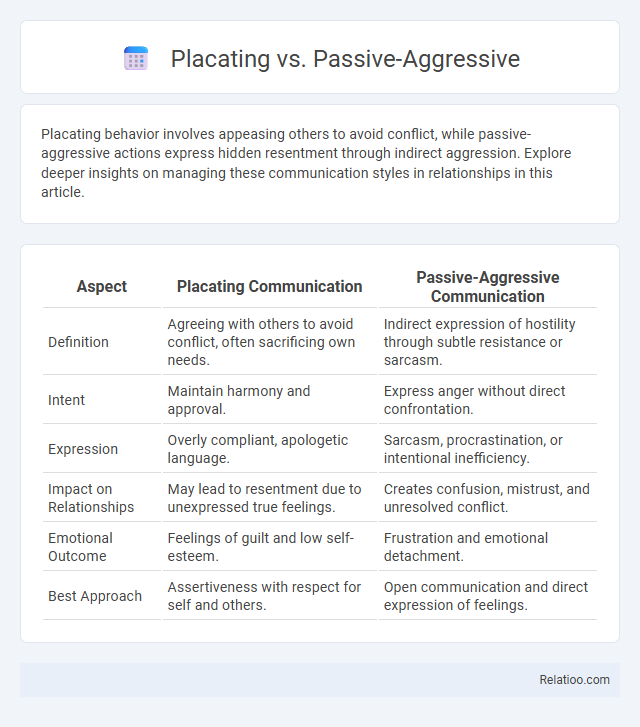Placating behavior involves appeasing others to avoid conflict, while passive-aggressive actions express hidden resentment through indirect aggression. Explore deeper insights on managing these communication styles in relationships in this article.
Table of Comparison
| Aspect | Placating Communication | Passive-Aggressive Communication |
|---|---|---|
| Definition | Agreeing with others to avoid conflict, often sacrificing own needs. | Indirect expression of hostility through subtle resistance or sarcasm. |
| Intent | Maintain harmony and approval. | Express anger without direct confrontation. |
| Expression | Overly compliant, apologetic language. | Sarcasm, procrastination, or intentional inefficiency. |
| Impact on Relationships | May lead to resentment due to unexpressed true feelings. | Creates confusion, mistrust, and unresolved conflict. |
| Emotional Outcome | Feelings of guilt and low self-esteem. | Frustration and emotional detachment. |
| Best Approach | Assertiveness with respect for self and others. | Open communication and direct expression of feelings. |
Understanding Placating: Definition and Characteristics
Placating involves attempting to pacify or appease others by agreeing or yielding to avoid conflict, often at the expense of one's own needs or feelings. It is characterized by excessive compliance, seeking approval, and suppressing personal opinions to maintain harmony. Understanding placating helps you recognize these patterns and develop healthier communication strategies that respect both your boundaries and relationships.
What Does Passive-Aggressive Behavior Mean?
Passive-aggressive behavior refers to indirect expression of negative feelings instead of openly addressing them, often manifesting through procrastination, sarcasm, or subtle sabotage. Unlike placating, which involves appeasing others to avoid conflict, passive-aggressive actions mask true emotions behind seemingly compliant or indifferent behavior. Understanding these distinctions helps you recognize and address unhealthy communication patterns effectively.
Key Differences Between Placating and Passive-Aggressiveness
Placating involves openly agreeing or appeasing others to avoid conflict, whereas passive-aggressiveness expresses hostility indirectly through sarcasm, procrastination, or subtle undermining. Your behavior in placating is transparent and conciliatory, aiming to maintain peace, while passive-aggressive actions mask true feelings, often causing confusion and resentment. Understanding these key differences helps improve communication by recognizing when someone is genuinely seeking harmony versus covertly expressing frustration.
Psychological Roots of Placating and Passive-Aggressive Behaviors
Placating behavior stems from deep-seated fears of rejection and a strong desire to maintain harmony, often leading you to suppress your own needs to please others. Passive-aggressive behavior originates from unresolved anger and helplessness, manifesting as indirect resistance or subtle sabotage instead of open confrontation. Both behaviors reveal underlying psychological struggles with assertiveness and emotional expression, impacting interpersonal dynamics significantly.
Common Triggers for Placating Responses
Common triggers for placating responses include fear of conflict, desire for approval, and low self-esteem, often arising in environments where safety feels threatened or criticism is frequent. Individuals may suppress their own needs to maintain harmony, leading to excessive people-pleasing behaviors. Understanding these triggers helps distinguish placating from passive-aggressive responses, which involve indirect resistance rather than overt appeasement.
Signs of Passive-Aggressive Communication
Passive-aggressive communication is characterized by indirect expressions of hostility such as sarcasm, backhanded compliments, and deliberate procrastination, often masking true feelings behind a placating or agreeable facade. Unlike placating, which involves overtly agreeing or appeasing to avoid conflict, passive-aggressive behavior subtly undermines relationships through avoidance, silent treatment, or intentional inefficiency. Recognizing these signs is crucial for addressing underlying issues and fostering healthier, more direct communication.
Emotional Impact: Placating vs Passive-Aggressive in Relationships
Placating behaviors often lead to suppressed emotions and unaddressed needs, creating a fragile dynamic where Your feelings are minimized to avoid conflict. Passive-aggressive actions, by contrast, fuel resentment and confusion through indirect expressions of anger, eroding trust in relationships. Understanding these emotional impacts is crucial for fostering authentic communication and healthier connections.
How Placating and Passive-Aggressive Behaviors Affect Workplaces
Placating behavior in workplaces often leads to unresolved conflicts as employees avoid addressing issues directly, resulting in decreased productivity and morale. Passive-aggressive actions manifest through indirect resistance and hidden hostility, creating mistrust and communication breakdowns among team members. Both behaviors undermine effective collaboration, fostering a toxic environment that hampers organizational success and employee engagement.
Strategies to Move from Placating or Passive-Aggressiveness to Assertiveness
Understanding the differences between placating and passive-aggressive behaviors is crucial for developing assertiveness, as placating often involves excessive compliance to avoid conflict, while passive-aggressiveness hides resentment behind indirect actions. To move towards assertiveness, you can practice clear communication by expressing your needs and feelings openly without fear of judgment and setting healthy boundaries to protect your well-being. Building self-awareness and engaging in reflective exercises help you recognize patterns of placating or passive-aggressiveness so that your responses become more balanced and confident in social or professional interactions.
Building Healthy Communication: Breaking the Cycle
Placating involves excessive people-pleasing to avoid conflict, while passive-aggressive behavior disguises hostility through indirect actions, both hindering transparent communication. Recognizing these patterns enables individuals to establish authentic dialogue, fostering trust and mutual respect. Breaking the cycle requires embracing assertive communication techniques that promote emotional honesty and conflict resolution.

Infographic: Placating vs Passive-Aggressive
 relatioo.com
relatioo.com